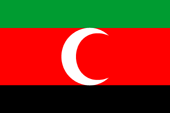mobile View, to the German Version tap the flag


- former Sultanate
- region in the West of Sudan, in struggle for perpetuation of its cultural identity
- own name, Arabian: Dar Fur
• Flag
• Meaning/Origin of the Flag
• Map
• Numbers and Facts
• History
• Origin of the Country's Name

National flag ,
ratio = 2:3,
Source nach by: World Statesmen




The flag of Darfur shows three horizontal stripes in green, red and black in a ratio of 1:2:1 with a white crescent in the middle red stripe. The crescent stands for the Islam as dominating religion. This flag was the flag of the Sultanate of Darfur, which existed between 1603 and 1916. Red, white, green, and black are very important colours in Islam, which are often found on flags: Red is the color of Omar, the second caliph; White stands for the Omajiads, a caliph dynasty that goes back to the fifth caliph Moawija I; Green stands for the Fatimids, an Ismaili-Shiite caliph dynasty that goes back to the fourth caliph Ali; and black stands for the Abbasids, a caliph dynasty that goes back to the Caliph Abbas I.
Source: Volker Preuß

Interactive Map of the Sudan:

Source: Freeware, University of Texas Libraries,
modyfied by: Volker Preuss

Area: 196.554 square miles
Inhabitants: 8.000.000 (2020), thereof 30% Fur, 70% Arabs, Sogawah, Bideajat, Bisharin, Fulbe, Massalat, Tukrur
Density of Population: 41 inh./sq.mi.
Capital: El-Fasher (Al-Faschir), 286.277 inh. (2009)
official Language: Arabian
other Languages: English, Khundshara, regional dialects
Currency: Sudanese Currency
Time Zone: GMT + 2 h
Source:
Wikipedia (D),
RetroBib Retrobibliothek

antiquity · settlement by the Dadjo tribe, immigration of Fur, expulsion of Dadjo
600 · Christianization
900–1200 · christian kingdoms in the today’s Darfur, islamic attacks
13th cent. · the christianity in the today’s Darfur breaks down under the arabian-islamic onslaught, parts in the west of the country come unser the rule of the islamic Empire of Bornu-Kanem
ca. 1620 · islamization of Darfur
1640 · the Keira-Family takes over the control in Darfur and nominates itself to sultans and unifys the country
1787–1821 · Kordofan belongs to Darfur
1821–1833 · Darfur is occupied by egypt troops
1874 · invasion of egypt troops, battle of Menawashi (Manawaki), defeat of Darfur, death of Sultan Brahim of Darfur
1875–1881 · the Egyptians try to stop the slave trading
1881–1898 · anti-egyptian-clerical Mahdi revolt under the leadership of Mohammed Achmed, named Mahdi, formation of the Mahdi Empire
1882 · United Kingdom occupys Egypt
1883 · anti-egyptian revolt, Darfur declares its independence
1883 · Darfur has to submit itself the expanding Mahdi State, Sultan Jussuf of Darfur becomes officialy deployed by the Mahdi as a vassal
1885 · death of the Mahdi, successor is Chalifa Abdullahi
1888 · Sultan Jussuf of Darfur declares Darfur as independent, invasion of troops of the Mahdi State, battle of El-Fascher, defeat of the troops of Darfur, Darfur becomes once more subjected to the Mahdi State
1889 · revolt of the Darfurians under Abu Djimesa fails because of his death and the invasion of Mahdi-troops from the Taasha tribe
1898 · battle of Omdurman, destruction of the Mahdi State by british-egyptian troops, the Sultan of Darfur recognizes the british-egyptian supremacy
1916 · anti-british revolt, invasion of british troops, battle of Zalingi, death of the Sultan, Darfur becomes a province of the Anglo-Egypt Sudan
1994 · Darfur becomes divided into three provinces: Gharb Darfur (Western Darfur), Shamal Darfur (Northern Darfur) and Janub Darfur (South Darfur)
2003 · outbreak of the Darfur Conflict, African rebels start the struggle against the Arabian government of the Sudan, governmental troops and militia exile 2,5 million residents, 400.000 perish
2004 · peace treaty between Darfur and Sudan fails
Source: Wikipedia (D),
RetroBib Retrobibliothek

The name of "Darfur" is derived from the Arabian denomination "Dar Fur". That means "House of the Fur" and describes the settlement area of the negro people of the Fur, which settled here since the antiquity.
Source: Handbuch der geographischen Namen


![]()





